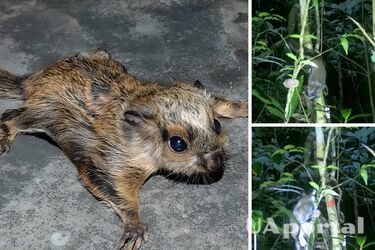Flying squirrels in China have developed a clever way to hide their nuts (video)

Scientists have discovered that two species of flying squirrels that live in the southern rainforests of China have an interesting strategy for storing nuts.
They gnaw grooves in smooth, ovoid or rounded nuts and secure them firmly between branches in a high and dry place.
According to a study published in the journal eLife, this is indicative of the cognitive and engineering skills of these animals and may also contribute to the even distribution of nut trees in the rainforest.
It is noted that squirrels usually bury nuts or store them in tree hollows or logs, but tropical rainforests do not provide such opportunities, as nuts quickly decompose or germinate in the ground.
The researchers observed flying squirrels placing nuts in specially gnawed grooves located at a low height above the ground between branches. They carefully position the nuts so that the branches are closely wedged into the grooves, creating a strong connection similar to that of a mortise-and-tenon joint.
Read also: Crazy squirrel bites people in Chernivtsi
This nut storage strategy allows flying squirrels to protect their food supply from competitors and save it for lean periods. In addition, placing the nuts at a distance from other trees and above ground helps seed dispersal and contributes to the overall ecology of the rainforest.
The scientists used infrared cameras to observe the nut storage process and found that Indochinese flying squirrels and colorful flying squirrels were the main participants in this process.
This study reveals new aspects of animal behavior and important adaptations to the environment. Understanding such strategies may be important for the conservation of tropical forests and maintaining ecological balance in these regions.
The Chinese giant flying squirrel (Petaurista xanthotis) is a species of rodent in the family Sciuridae. It is endemic to China. This squirrel lives in the alpine spruce forests of China. It feeds at night on young shoots, leaves, and pine nuts. It nests in trees but does not hibernate.
We offer you to find out why scientists put "thongs" with trackers on frogs.
If you want to get the latest news about the war and events in Ukraine, subscribe to our Telegram channel!
